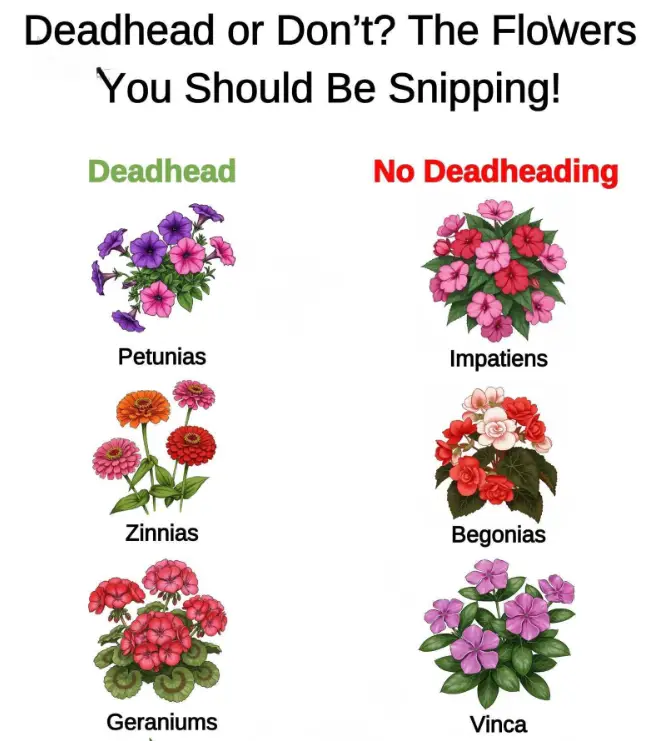Which Flowers Benefit Most (And Which Don’t Need It)
Deadheading, the process of removing faded or spent blooms, is a powerful technique for enhancing floral displays and promoting vigorous, continuous blooming. While some flowers respond incredibly well to this method, others are naturally self-cleaning and do not require any intervention. In this article, we’ll explore in detail which flowers benefit most from deadheading and which do not, along with best practices to maximize your garden’s blooming potential.
What Is Deadheading and Its Purpose in Gardening
Deadheading is the horticultural practice of removing spent blooms from flowering plants. By doing so, we redirect the plant’s energy from seed production back into creating new blossoms, extending the flowering season, and improving the plant’s overall appearance.
Key benefits of deadheading include:
- Extended blooming periods
- Healthier and fuller plants
- Enhanced garden aesthetics
- Reduction in unwanted seed dispersal
Essential Tools for Effective Deadheading
To carry out deadheading efficiently, only a few tools are needed:
- Sharp pruning shears or scissors: Ideal for tough stems.
- Garden gloves: Protect hands from thorns or sticky sap.
- Your fingers: Suitable for soft-stemmed plants like cosmos or marigolds.
Regular inspection and removal of spent blooms can transform your garden from good to exceptional.
Top 7 Flowers That Thrive With Deadheading
1. Petunias
Petunias respond exceptionally well to deadheading. This plant tends to become leggy without regular maintenance, and deadheading encourages compact growth and nonstop blooming. Be sure to remove the entire flower stem just above the next set of leaves.
2. Zinnias
Zinnias are prolific bloomers, and with proper deadheading, their vibrant display can last well into the fall. Cutting off old flowers encourages new bud formation and prevents the plant from diverting energy into seed development.
3. Geraniums (Pelargoniums)
Geraniums benefit from the removal of faded flower clusters. Deadheading geraniums stimulates the development of fresh flower heads, improving both appearance and bloom longevity. Always cut back to just above the node where a new bud is forming.
4. Marigolds
Marigolds are loved for their bright, cheerful blooms. Deadheading them not only promotes more flowers but also helps in reducing fungal issues by increasing air circulation. This makes your marigold beds look clean and continuously in bloom.
5. Cosmos
Cosmos are lightweight, airy plants that thrive on deadheading. When old blooms are removed, cosmos quickly respond with fresh flushes of color. They are ideal for flower beds where minimal effort yields maximum reward.
6. Coneflowers (Echinacea)
While not strictly necessary, deadheading coneflowers early in the season results in a fuller flush of blooms. Later in the season, leaving the seed heads intact provides food for birds and adds visual interest.
7. Blanket Flower (Gaillardia)
Deadheading is essential for gaillardias to prolong the blooming cycle. These flowers tend to bloom profusely, and consistent deadheading maintains their appearance and health throughout the growing season.
5 Flowers That Don’t Require Deadheading
1. Impatiens
Impatiens are self-cleaning plants. Their faded blooms naturally fall away, eliminating the need for manual deadheading. These are perfect for low-maintenance gardeners who want color without constant care.
2. Begonias (Most Types)
Most begonias, especially wax and tuberous varieties, keep themselves tidy. Regular watering and light pruning are all they need. Their automatic shedding of old blooms keeps them neat and appealing.
3. Vinca (Periwinkle)
Vinchas are tough, drought-tolerant, and require no deadheading. Manual removal of blooms can even damage their structure. Simply let them do their thing, and they’ll provide continuous color all season.
4. Lobelia
While lobelias may look delicate, they are efficient at self-grooming. Deadheading isn’t necessary unless the plant becomes leggy, in which case a light trim will revitalize its appearance.
5. Sweet Alyssum
Despite their name and appearance, sweet alyssums are hardy and low-maintenance. Instead of deadheading, a light shearing after the first bloom can stimulate renewed flowering and compact growth.
Advanced Deadheading Tips for Maximum Bloom Output
1. Know Your Flowering Timeline
Each plant has a unique blooming cycle. Deadheading should be done after the flower fades but before it sets seed. Familiarize yourself with your plants’ schedules for best results.
2. Don’t Just Snip — Inspect
Always check the base of the bloom. Cut back to a leaf node or branching point, not just the flower head, to encourage healthy new growth.
3. Regular Maintenance
Incorporate deadheading into your weekly routine. Timely removals prevent disease, conserve plant energy, and maintain the visual appeal of your garden.
4. Sanitize Your Tools
To avoid spreading disease between plants, sanitize scissors or shears with alcohol or a bleach solution after each use.
5. Dispose of Spent Blooms Properly
Do not compost diseased or pest-infested flowers. Remove them completely from your garden to avoid infestations and fungal outbreaks.
Common Deadheading Mistakes to Avoid
- Cutting too far down the stem, which can stunt growth
- Leaving dead blooms on the soil, inviting pests and rot
- Over-pruning during extreme heat or cold, stressing the plant
- Deadheading when seeds are desired, especially for propagation
By avoiding these pitfalls, gardeners can ensure that their flowers not only survive but thrive spectacularly.
Conclusion
While not every flower requires deadheading, those that do benefit immensely from the practice. From the ever-blooming petunias to the colorful zinnias and the beloved marigolds, understanding which flowers need care and how to provide it will enhance your garden’s productivity and charm.
At the same time, it’s equally important to recognize self-cleaning varieties like impatiens and vincas, allowing gardeners to focus their efforts more efficiently.
Embrace deadheading not as a chore, but as a powerful tool in your gardening arsenal, and watch your landscape transform into a lush, color-filled paradise.

